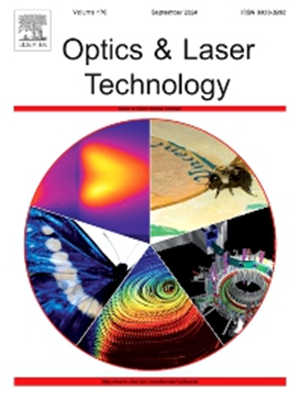基于 Cu-MOFs/PAN 膜腔的温度自补偿光纤偏差传感器,用于检测碳酸二甲酯气体
IF 4.6
2区 物理与天体物理
Q1 OPTICS
引用次数: 0
摘要
碳酸二甲酯(DMC)在新能源电解液中扮演着重要角色,因此 DMC 气体检测的重要性不言而喻。本文报道了一种基于金属有机框架(MOFs)的光纤 DMC 气体传感器。光纤结构由两段四模光纤(FMF)和一段拼接错位无芯光纤(COF)组成。马赫-泽恩德干涉仪(MZI)的传感臂是通过电纺丝在 COF 和 FMF 的错位间隙中填充铜-MOFs/聚丙烯腈(PAN)而构建的,COF 作为参考臂。同时,通过在 COF 的另一侧沉积氧化银/氧化锌(ZnO)薄膜来激发表面等离子体共振(SPR),并通过电纺丝沉积 PAN 作为温度敏感层。研究结果表明,MZI 的 DMC 灵敏度为 93.25 pm/ppm,SPR 的温度灵敏度为 596.2 pm/°C。基于双参数矩阵解调的 DMC 气体浓度和温度误差分别为 E (ΔC) = 1.38 % 和 E (ΔT) = 1.80 %。最后,成功分析了锂电池泄漏时 DMC 气体浓度和温度的变化。该传感器具有制造简单、体积小、灵敏度高等优点,在锂电池监测方面具有潜在的应用前景。本文章由计算机程序翻译,如有差异,请以英文原文为准。
Temperature self-compensating fiber-optic misalignment sensor based on Cu-MOFs/PAN film cavity for detecting dimethyl carbonate gas
Dimethyl carbonate (DMC) plays an important role in the electrolyte of new energy, so the importance of DMC gas detection is self-evident. This article reports a fiber-optic DMC gas sensor based on metal organic frameworks (MOFs). The fiber structure consists of two sections of four mode optical fiber (FMF) and one section of splicing misaligned centerless optical fiber (COF). The sensing arm of Mach-zehnder interferometer (MZI) is constructed by filling Cu-MOFs/polyacrylonitrile (PAN) by electrospinning in the misalignment gap between COF and FMF, with the COF serving as the reference arm. At the same time, surface plasmon resonance (SPR) is excited by depositing a Ag/zinc oxide (ZnO) film on the other side of the COF, and PAN is deposited as a temperature sensitive layer by electrospinning. The research results indicate that the DMC sensitivity of MZI is 93.25 pm/ppm, and the temperature sensitivity of SPR is 596.2 pm/°C. The DMC gas concentration and temperature errors based on dual parameter matrix demodulation are E (ΔC) = 1.38 % and E (ΔT) = 1.80 % respectively. Finally, the changes of DMC gas concentration and temperature during the leakage of lithium battery are successfully analyzed. This sensor has the advantages of simple manufacturing, small size, and high sensitivity, and has potential application prospects in terms of lithium battery monitoring.
求助全文
通过发布文献求助,成功后即可免费获取论文全文。
去求助
来源期刊
CiteScore
8.50
自引率
10.00%
发文量
1060
审稿时长
3.4 months
期刊介绍:
Optics & Laser Technology aims to provide a vehicle for the publication of a broad range of high quality research and review papers in those fields of scientific and engineering research appertaining to the development and application of the technology of optics and lasers. Papers describing original work in these areas are submitted to rigorous refereeing prior to acceptance for publication.
The scope of Optics & Laser Technology encompasses, but is not restricted to, the following areas:
•development in all types of lasers
•developments in optoelectronic devices and photonics
•developments in new photonics and optical concepts
•developments in conventional optics, optical instruments and components
•techniques of optical metrology, including interferometry and optical fibre sensors
•LIDAR and other non-contact optical measurement techniques, including optical methods in heat and fluid flow
•applications of lasers to materials processing, optical NDT display (including holography) and optical communication
•research and development in the field of laser safety including studies of hazards resulting from the applications of lasers (laser safety, hazards of laser fume)
•developments in optical computing and optical information processing
•developments in new optical materials
•developments in new optical characterization methods and techniques
•developments in quantum optics
•developments in light assisted micro and nanofabrication methods and techniques
•developments in nanophotonics and biophotonics
•developments in imaging processing and systems

 求助内容:
求助内容: 应助结果提醒方式:
应助结果提醒方式:


